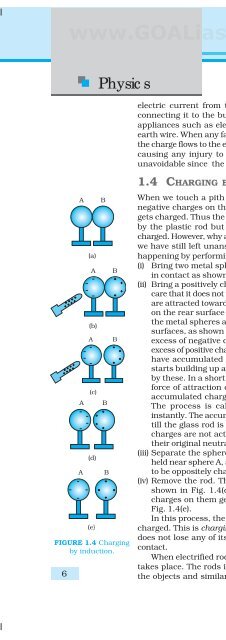com www.GOALias.blogspot.com
com www.GOALias.blogspot.com
com www.GOALias.blogspot.com
- No tags were found...
You also want an ePaper? Increase the reach of your titles
YUMPU automatically turns print PDFs into web optimized ePapers that Google loves.
<strong>www</strong>.<strong>GOALias</strong>.<strong>blogspot</strong>.<strong>com</strong>Physicselectric current from the power station and the third is earthed byconnecting it to the buried metal plate. Metallic bodies of the electricappliances such as electric iron, refrigerator, TV are connected to theearth wire. When any fault occurs or live wire touches the metallic body,the charge flows to the earth without damaging the appliance and withoutcausing any injury to the humans; this would have otherwise beenunavoidable since the human body is a conductor of electricity.FIGURE 1.4 Chargingby induction.61.4 CHARGING BY INDUCTIONWhen we touch a pith ball with an electrified plastic rod, some of thenegative charges on the rod are transferred to the pith ball and it alsogets charged. Thus the pith ball is charged by contact. It is then repelledby the plastic rod but is attracted by a glass rod which is oppositelycharged. However, why a electrified rod attracts light objects, is a questionwe have still left unanswered. Let us try to understand what could behappening by performing the following experiment.(i)Bring two metal spheres, A and B, supported on insulating stands,in contact as shown in Fig. 1.4(a).(ii) Bring a positively charged rod near one of the spheres, say A, takingcare that it does not touch the sphere. The free electrons in the spheresare attracted towards the rod. This leaves an excess of positive chargeon the rear surface of sphere B. Both kinds of charges are bound inthe metal spheres and cannot escape. They, therefore, reside on thesurfaces, as shown in Fig. 1.4(b). The left surface of sphere A, has anexcess of negative charge and the right surface of sphere B, has anexcess of positive charge. However, not all of the electrons in the sphereshave accumulated on the left surface of A. As the negative chargestarts building up at the left surface of A, other electrons are repelledby these. In a short time, equilibrium is reached under the action offorce of attraction of the rod and the force of repulsion due to theaccumulated charges. Fig. 1.4(b) shows the equilibrium situation.The process is called induction of charge and happens almostinstantly. The accumulated charges remain on the surface, as shown,till the glass rod is held near the sphere. If the rod is removed, thecharges are not acted by any outside force and they redistribute totheir original neutral state.(iii) Separate the spheres by a small distance while the glass rod is stillheld near sphere A, as shown in Fig. 1.4(c). The two spheres are foundto be oppositely charged and attract each other.(iv) Remove the rod. The charges on spheres rearrange themselves asshown in Fig. 1.4(d). Now, separate the spheres quite apart. Thecharges on them get uniformly distributed over them, as shown inFig. 1.4(e).In this process, the metal spheres will each be equal and oppositelycharged. This is charging by induction. The positively charged glass roddoes not lose any of its charge, contrary to the process of charging bycontact.When electrified rods are brought near light objects, a similar effecttakes place. The rods induce opposite charges on the near surfaces ofthe objects and similar charges move to the farther side of the object.
















